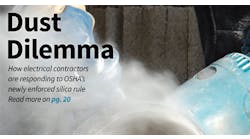When it's cold outside, I'm typically sitting in my office at work on the 4th floor of a five-story building suffocating from the dry heat being pumped into my office. Then, of course, when it's hot outside, I'm generally freezing from the cold air relentlessly blowing down the back of my neck. To make matters worse on the climate-control front, it doesn't help that multiple thermostats located throughout the floor are accessible to all employees. Given the present situation, I've resorted to blocking off my floor vents with boxes — even creating a special homemade wind guard for my overhead vent.
But the HVAC system isn't the only antiquated system in my office building. Our overhead lighting system still features 3×4 trouffers with T-12 lamps. Individual offices are equipped with their own light switch, but they lack occupancy sensors. The same holds true for the main floor area where the majority of cubicles are situated. Unoccupied areas are generally left lit for hours at a time before the cleaning staff shuts them off in the wee hours of the night.
If the building encounters a power outage over the weekend, you guessed it, employees arriving first thing Monday morning are the first to know. By then it's too late to notify everyone of the problem — as the crowd of people starts gathering in the parking lot outside the inaccessible building.
You might think that I work in a 75-year-old building, but this structure can't be more than 25 years old. When I stop to think about how many other buildings in this country fit this same profile, it makes me realize how much energy's being wasted — not to mention the growing number of uncomfortable and unhappy workers that inhabit them.
Most discussions today surrounding the so-called smart building movement highlight the benefits of installing sophisticated equipment and systems in new facilities, as does our cover story this month, “Building Intelligence,” written by Staff Writer Beck Finley (see page 50). Preaching the merits of designing and constructing new commercial and industrial buildings with so-called built-in intelligence, smart builders today create an integrated network of subsystems such as fire, security, access control, energy, lighting, communications, and HVAC systems that can be monitored and controlled via a centralized interface, located either onsite or remotely.
But what about the hundreds of thousands of commercial buildings that already exist — the buildings that house millions of workers like me (and some of you), who are continually uncomfortable and dissatisfied with our work environments? The buildings that are terribly inefficient and in need of system upgrades, which if performed would lower their energy demand and make them operationally more efficient, are the ones in need of the most attention. This is where you can support my cry for help.
Continue to educate yourself on the merits of intelligent building design. Keep abreast of changes in technology in other disciplines. Work with vendors and manufacturers to help them create better products and systems to meet your needs. But most of all, continue to espouse the merits of smart building systems for both new and existing buildings with each and every one of your customers. The more convincing you are on the front end of this mission, the more projects should come your way. More importantly, the happier you'll make people like me!


